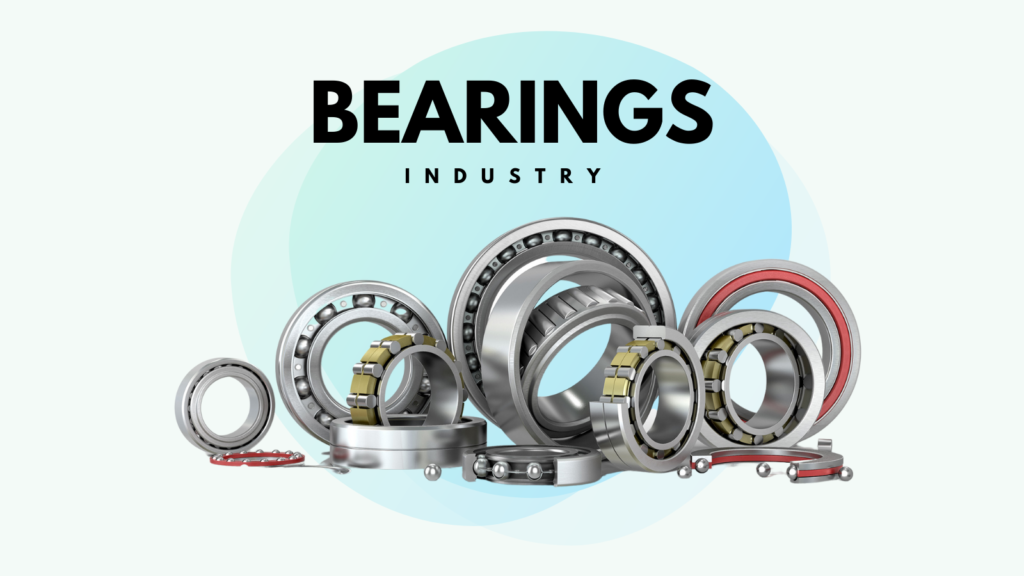The inception of the Bearings Industry: The First bearing was the “Ball Bearing” Discovered in 1794 by Philip Vaughan, a Welsh ironmaster.


Quick Links. Click to navigate directly to the paragraph in detail:
- Introduction to Bearings
- Classification of Bearings
- Overview of Industry
- Market Size of Indian Bearing Industry
- Bearing Industry Trend Analysis
- Top Key Players of the Indian Bearing Industry
- Growth opportunities
- Threats for the Bearings Industry
- Conclusion
(I) Introduction to Bearings

The word “bearing” incorporates the meaning of to bear, in the sense of to support, and to carry a burden. This refers to the fact that bearings support and carry the burden of different types of moving elements. Bearings reduce friction and allow a controlled and efficient transmission of power.
Well, Bearings are one of the important components that reduce friction and enhance motion between objects. Usually Bearing Known as anti-friction components, they are widely used in automobiles, pumps, gear boxes, heavy earth moving equipment.
The Most used ball bearings made of steel known as high carbon chromium steel, often called chrome steel. This is used for reasons of cost and durability. Bearings are also made from other materials such as stainless steel, ceramics and plastic.
(II) Classification of Bearings
In India, The most commonly used bearing is Ball bearing. Ball Bearings are mechanical assemblies that consist of rolling spherical elements that are capture between circular inner and outer races.
In Simple words, Its a kind of bearing which consists Ring and Balls that helps the machine to rotate, to reduce friction and to carries load.
However, there are so many other bearing also which are widely using in the automotive and Industrial industry such as Spherical Roller Bearings, Cylindrical Roller Bearings, Jewel and Slide Bearings and many more.

(III) Overview of Indian Bearings Industry
Bearing which is a important component of many industrial machines and Automotive Vehicles are generally manufacture by High engineering with different material and sizes.
The total Indian bearings Industry, comprising both ball bearings and roller bearings, valued at USD 1.8 billion in 2021. However, The Indian bearings industry expected to grow at 10.9% CAGR to reach USD 3.4 billion by 2027.
With the gradual improvement in the fresh announcement of capex and execution of existing projects on ground, demand for short cycle products such as bearings, pumps, material handling equipment, construction equipment, abrasives, etc. is likely to witness an uptick.
Additionally, In India, ~50,000 sizes of various configuration of bearings are required and the local established industry players hardly produce 5,000 sizes leaving the gap of 45,000 sizes for import out of which around 50% are met by MNCs directly and the rest from CIS and Chinese imports
(IV) Market Size of Indian Bearing Industry
The Indian Bearings Industry expected to grow from USD 1.8 Bn (2021) to USD 3.4 Bn (2027) at a CAGR of 10.9% during 2021 to 2027. However, The total Indian bearings Industry, comprising both ball bearings and roller bearings valued at USD 1.8 billion in 2021.
In 2020, Indian bearings Industry accounted for a share of about 4.7% in the global bearings market.
Meanwhile, within Asia Pacific region, the revenues for bearings market in India accounted for a share of about 11.6% of the Asia Pacific region’s revenues.

During, 2015 to 2021 Indian Bearing Market Grew at CAGR of 7.2%.
whereas, In 2020 a sudden Fall has been Seen due to global Covid-19 which affected demand and led negative earnings.
Moreover, It is estimated that < 50% of the consumption of bearings in the country is met through domestic production. Meanwhile, less than 40% of the demand met through imports and it has
been declining due to increasing localization by multinational players operating in the domestic
bearing industry.
Additionally, It is likely that bearing players will make further investments to enhance product
localization which will lead to decline in imports and in turn encourage domestic production.
(V) Bearing Industry Trend Analysis
(a) By Bearings Type

(b) Sales Growth Trend in Application Type

(c) Import and Export Trend
In 2016, India exported $388.7mn ball or roller bearings that has grew at CAGR of 4.2% during 2016-2020.
On the other hand, India imported $890.6mn ball or roller bearings in 2016 and grew at a CAGR of -1.6%.during 2016 to 2020 to moderate to USD 834.3 million in 2020.

(VI) Top Key Players of the Indian Bearing Industry
The global market dominated by few players due to their diverse product portfolio, higher production capacities and competitive pricing models.
The manufacturers are focusing on bringing technological innovations in the automotive bearings manufacturing to improve productivity and lower the costs.
On the contrary, few players operating their manufacturing at utilization level of 70-75% now which they had expanded to 80-90%.

(VII) Growth opportunities for Bearings Industry
(a) Diverse Applicant user
As a crucial component, bearings required in every industry like Milk to Coal extracting companies, Fans to Railway coach manufacturing. Every machine needs a certain type or size of bearing in order to keep running machines.
Automobile sector is contributing the most in Indian bearing market with the share of ~23%. In fact, on an Average basis a car requires 36 bearings.
Even, as of now other sectors like Aviation & Aerospace, Railways, Construction are also contributing in the range of 13% to 20% each.
Moreover, There is a growing thrust on adoption of electric vehicles (EV) across the globe amid increasing
carbon emissions, Eventually which will push more demand.

(b) Favorable policies and regulatory framework
The government plans to develop India as a manufacturing hub and has introduced several schemes like Make In India, PLIs to attract foreign players to set up their manufacturing units in the country.
(The PLI Scheme for Automobile and Auto Component has succeeded in attracting proposed investment of₹ 74,850 crore against the target estimate of investment ₹ 42,500 crore over a period of five year)
The schemes aimed making India globally competitive & enhance exports to make India an integral part of the global supply chain.
In addition, The central Government Introduced several policies like transformation of Scrappage Policies, BSIV to BSVI and CAFE Norms which aimed at lowering fuel consumption/improving fuel efficiency by lowering carbon emissions.
(c) Growing demand from end users
In terms of market growth, the domestic mobility industry has lot of potential aided by factors such as population size, geographical spread and the current low penetration.
In addition, growth in goods mobility segment is being led by the need to establish strong supply chains between producers and market which will be supported by investments being made to enhance connectivity by varied modes of transport like roads, railways etc.
(d) Manufacturers diversifying global supply chain network
China as a global manufacturing hub, but recent industry developments such as US-China trade war and the global outbreak of Covid-19 has highlighted the need for manufacturers to diversify their supply chain network.
Several manufacturers including global bearing players are protecting them by shifting their manufacturing plants from china to India with eyeing of enough potential and advantage of low-cost manufacturing
(e) Advancements in Technology with digitization and IoT
key enablers like advancements in technology with digitization, Internet of Things (IoT) will drive the demand for bearings components.
Moreover, the bearing manufacturers are continuously working to develop customize bearings as per end user requirements which is likely to benefit the bearing cages manufacturers as well.
(VIII) Threats for the Bearings Industry
(a) Volatility in Raw material Prices
Steel is one of the primary raw material use in the manufacturing of bearing components. Its fluctuating prices affects the operational income of bearing component manufacturers.
In fact, Raw material cost accounts for around 50-66% of bearings manufacturer’s revenue.
However, The average price of HRC (2.5 mm) and CRC (1mm) grew at a CAGR of 16.6% and 15.9%
respectively from April 2019 to December 2021.
(b) Rapid Digitalization
Bearing manufacturers are facing several challenges due to increasing digitalization of the entire value chain spanning across design, manufacturing, procurement and maintenance.
Non-uniform rate in adopting technologies due to differentiated capabilities, lack of knowledge and minimal availability of design skills lead to challenges in technological advancement.
(c) Unfavorable Action from the parent company
Indian Bearings industry mostly covered with foreign Group Companies, Like The Timken Company, SKF Bearings, Schaeffler and so on. Any misconception or irregulates found in the group may lead to adverse impact on the subsidiaries companies.
(IX) Conclusion
Before, Covid-19 outbreak, Lockdown restrictions across nation, Indian Automobile sector was facing turmoil due to cyclical issues. After, in 2021 semi conductors shortage and Russia-Ukraine war affected the Automobile sector. Subsequently that leads to equal adverse affect on bearing industry.
But now, as Automobile is recovering it positively contributing to the bearings industry. By accelerating value chain processes, and building future capabilities, the industry quickly adapted to meet the demands. As the Indian automobile industry further innovates, there are tremendous opportunities available.
Similarly, for the industrial sector, increasing applications in every sector ranging from medical and robotics to farm equipment, and household appliances to defense and aerospace, expected to benefit the bearings manufacturers.
Additionally, the growing focus of manufacturers on the production of lighter bearings by adopting newer technologies and lightweight alloys will further propel the growth of the market.



Drop us your query at – info@pawealth.in or Visit pawealth.in
References: Economic times Auto, Companies’ Annual reports, Media reports, Society of Indian Automobile Manufacturers (SIAM), Automotive Component Manufacturers Association of India (ACMA), Central Statistics Office (CSO), Database on Indian Economy, RBI, Office of Economic Adviser, PIB.
Disclaimer: The report only represents personal opinions and views of the author. No part of the report should be considered as recommendation for buying/selling any stock. The report & references mentioned are only for information of the readers about the industry stated.
Most successful stock advisors in India | Ludhiana Stock Market Tips | Stock Market Experts in Ludhiana | Top stock advisors in India | Best Stock Advisors in Gurugram | Investment Consultants in Ludhiana | Top Stock Brokers in Gurugram | Best stock advisors in India | Ludhiana Stock Advisors SEBI | Stock Consultants in Ludhiana | AMFI registered distributor | Amfi registered mutual fund | Be a mutual fund distributor | Top stock advisors in India | Top stock advisory services in India | Best Stock Advisors in Bangalore




